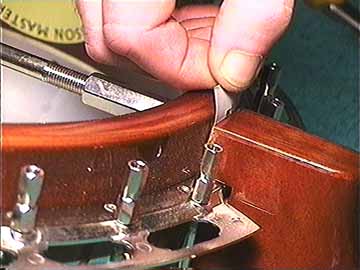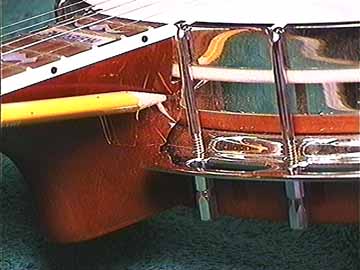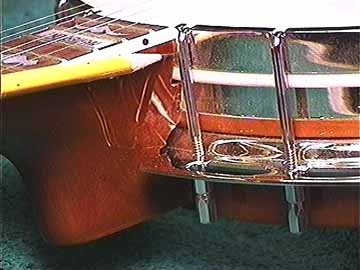Page 4 of 4
To adjust the neck angle of these banjos, I simply loosen the neck attaching nut:

In fact, I back it way off. Then I insert a shim between the neck and the shell
to improve the neck angle and the action. I find this is far superior to trying
to make the flimsy rod do a job that out of its league.
Shims are useful on better banjos, too. If the rods don't adjust the neck easily
enough, or if I sense the shell is straining when I crank on the rod nuts, I may
use shims to get the neck fitted a bit more closely to the desired angle:

This shim is a piece of heavy card stock, cut to clear the bolt, and trimmed so it
won't be too ugly.
The ideal fix for a bad neck angle is to recut the joint and refit the neck, but
that may not always be the best choice. Lots of players like to mess around with
different bridge heights, for example. It's also reasonable to shim a neck to try
out a new setup before making a permanent change. I personally don't get into the
discussion of whether the shim may influence the tone.
It's possible to shim the neck angle backward by cutting and fitting veneer or card
stock shims here:

or here:

or both.
Shimming the heel to force the neck backward will bring the action lower, and
is frequently a good choice when changing to a bridge higher than the standard
5/8" that was stock with this Mastertone.
All early banjos, and some high grade modern "old time" instruments have
their necks attached by a heavy "dowel stick" This 75 year old Vega has
no neck angle adjustment at all:

That heavy nickel plated yoke screws against the shell, pulling hard on the pin in
the dowel stick. That brings the neck up tight against the shell and makes it rigid
indeed. It is often possible to make slight neck angle adjustments by loosening
the clamp and inserting a shim at the end of the fingerboard. When the clamp is
tightened, the dowel will bend very slightly and the neck will be forced backward
a bit.
The bitter fact is that to reset the neck angle on one of these old timers, it's
necessary to remove the dowel from the neck and rebuild the joint entirely. A big
expensive job to say the least.
That's why I really LIKE banjo coordinating rods. I wish guitars could have 'em!
1
2
3
4
Back to Index Page